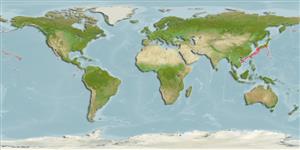Elasmobranchii (Haie und Rochen) (sharks and rays) >
Squaliformes (Sleeper and dogfish sharks) >
Etmopteridae (Lantern sharks)
Etymology: Trigonognathus: Greek, trigono = a triangle + Greek, gnathos = jaw (Ref. 45335). Refers to the triangular shape of the jaws (Ref. 31259); kabeyai: Named after Mr. Hiromichi Kabeya who collected the type specimens (Ref. 31259).
Environment: milieu / climate zone / depth range / distribution range
Ökologie
seewasser bathydemersal; tiefenbereich 330 - 360 m (Ref. 31259). Deep-water
Northwest Pacific: Wakayama and Tokushima, Japan (Ref. 31259). Reported from the Hawaiian Islands (Ref. 58302).
Length at first maturity / Size / Gewicht / Alter
Maturity: Lm 52.0 range ? - ? cm
Max length : 47.0 cm TL Männchen/unbestimmt; (Ref. 55729); 53.9 cm TL (female); max. veröff. Gewicht: 425.60 g (Ref. 55729); max. veröff. Gewicht: 425.60 g
Specimens collected between 330 and 360 m (Ref. 31259). Ovoviviparous (Ref. 205).
Life cycle and mating behavior
Geschlechtsreife | Fortpflanzung | Ablaichen | Eier | Fecundity | Larven
Distinct pairing with embrace (Ref. 205).
Mochizuki, K. and F. Ohe, 1990. Trigonognathus kabeyai, a new genus and species of the squalid sharks from Japan. Jap. J. Ichthyol. 36(4):385-390. (Ref. 31259)
IUCN Rote Liste Status (Ref. 130435)
Bedrohung für Menschen
Harmless
Nutzung durch Menschen
Mehr Information
Alter/GrößeWachstumLänge-GewichtLänge-LängeLängenhäufigkeitenMorphometrieMorphologieLarvenLarven Pop.Dyn.RekrutierungDichteBRUVS
ReferenzenAquakulturAquakultur ProfilZuchtlinienGenetikElectrophoresesVererbbarkeitKrankheitenVerarbeitungNutrientsMass conversion
PartnerBilderStamps, Coins Misc.LauteCiguateraGeschwindigkeitSchwimmstilKiemenoberflächeOtolithsGehirngrößeSehfähigkeit
Tools
Zusatzinformationen
Download XML
Internet Quellen
Estimates based on models
Preferred temperature (Ref.
123201): 10.4 - 16.3, mean 11.4 °C (based on 5 cells).
Phylogenetic diversity index (Ref.
82804): PD
50 = 1.0000 [Uniqueness, from 0.5 = low to 2.0 = high].
Bayesian length-weight: a=0.00372 (0.00188 - 0.00734), b=3.10 (2.92 - 3.28), in cm total length, based on LWR estimates for this (Sub)family-body shape (Ref.
93245).
Trophic level (Ref.
69278): 4.5 ±0.4 se; based on diet studies.
Widerstandsfähigkeit (Ref.
120179): niedrig, Verdopplung der Population dauert 4,5 - 14 Jahre. (Fec assumed to be <100).
Fishing Vulnerability (Ref.
59153): Moderate vulnerability (42 of 100).
